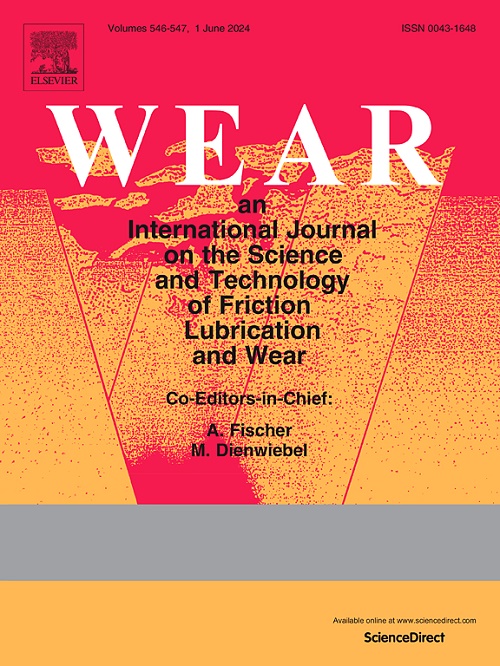原位 TiB2 增强和纳米沉淀对 ZE41 镁基复合材料磨损行为的协同效应
IF 5.3
1区 工程技术
Q1 ENGINEERING, MECHANICAL
引用次数: 0
摘要
二氧化碳污染和能源消耗的增加,增加了汽车和航空航天工业对镁等轻质材料的需求。然而,镁合金面临着耐磨性和机械强度差等挑战。为了克服这些限制,一种很有前景的方法是通过添加强化剂和微结构工程来开发异质混合微结构。本研究的重点是新开发的原位亚微米级 TiB2/ZE41 复合材料在各种微结构条件下的摩擦学性能,并将其与未增强的 ZE41 镁合金进行比较。在 10、20、40 和 60 N 的正常载荷和 1 m/s 的滑动速度下,使用针盘摩擦磨损试验机进行了磨损试验。使用扫描电子显微镜(SEM)和能量色散光谱(EDS)分析磨损表面,以确定损坏类型和表面变形。通过将磨损表面的微观结构与测试参数相关联,确定了每种材料在特定负载条件下的主要磨损机制。结果一致表明,无论负载条件如何,原位 TiB2 增强层、β 相和稀土析出物的存在都能增强耐磨性。此外,该研究还通过分析主要磨损机理、磨损引起的表面下变形机理、晶粒平均错位、晶粒取向扩散和显微硬度评估,建立了对有无原位 TiB2 颗粒和析出物的 ZE41 Mg 合金磨损行为的科学认识。本文章由计算机程序翻译,如有差异,请以英文原文为准。
Synergetic effect of in-situ TiB2 reinforcement and nano precipitation on wear behavior of ZE41 magnesium matrix composite
The rise in carbon dioxide pollution and energy consumption has increased the demand for lightweight materials such as magnesium in automotive and aerospace industries. However, magnesium alloys face challenges like poor wear resistance and mechanical strength. To overcome these limitations, a promising approach involves developing heterogeneous hybrid microstructures through reinforcement addition and microstructural engineering. This study focuses on the tribological performance of a newly developed in-situ sub-micron sized TiB2/ZE41 composite under various microstructural conditions, comparing it to the unreinforced ZE41 Mg alloy. Wear experiments were conducted using a pin-on-disc tribometer under normal loads of 10, 20, 40, and 60 N at a sliding velocity of 1 m/s. Scanning electron microscopy (SEM) coupled with energy dispersive spectroscopy (EDS) was used to analyze the worn surfaces in order to identify damage types and surface distortions. By correlating worn surface microstructures with test parameters, predominant wear mechanisms for each material condition under specific loads were determined. Results consistently showed that the presence of in-situ TiB2 reinforcements, β-phase, and rare-earth precipitates enhanced wear resistance regardless of the load conditions. Additionally, the study established a scientific understanding of the wear behavior of ZE41 Mg alloy, with and without in-situ TiB2 particles and precipitates, through analysis of dominant wear mechanisms, wear-induced subsurface deformation mechanisms, kernel average misorientation, grain orientation spread, and microhardness evaluation.
求助全文
通过发布文献求助,成功后即可免费获取论文全文。
去求助
来源期刊

Wear
工程技术-材料科学:综合
CiteScore
8.80
自引率
8.00%
发文量
280
审稿时长
47 days
期刊介绍:
Wear journal is dedicated to the advancement of basic and applied knowledge concerning the nature of wear of materials. Broadly, topics of interest range from development of fundamental understanding of the mechanisms of wear to innovative solutions to practical engineering problems. Authors of experimental studies are expected to comment on the repeatability of the data, and whenever possible, conduct multiple measurements under similar testing conditions. Further, Wear embraces the highest standards of professional ethics, and the detection of matching content, either in written or graphical form, from other publications by the current authors or by others, may result in rejection.
 求助内容:
求助内容: 应助结果提醒方式:
应助结果提醒方式:


